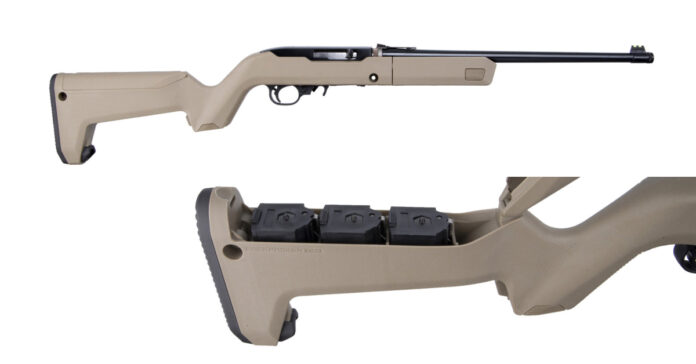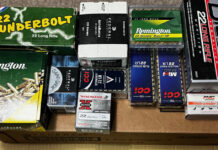Six weeks ago, I wrote about my Get Home Kit and the problems associated with having a .308 battle rifle as the primary weapon in my truck. Today, I’m going to discuss my solution to that conundrum.
First, I have decided to leave my .308 in the contractor box on the back of my truck. Yes, it is heavy. Yes, I would rather carry food than 12-pounds of rifle and ammo. Nonetheless, the rifle is there for a reason: because the large caliber is better than the 5.56 for punching through cars, windshields, walls, and other barriers. Do I expect to get into some wild gunfight where I am shooting at people in or behind cars? No, I don’t expect to, but the possibility exists. I have carried that gun in my truck since 2003 and I’ve never needed it, but that doesn’t mean the day will never come. So it’s going to stay in there.
This rifle also gives me the option of engaging targets at long range. It has a 4X scope. On a long stretch of empty highway with little cover, this combo might be important.
Second, I have added a Ruger 10/22 takedown rifle to the box on the back of my truck. I accessorize it with a 1-4x scope with an illuminated reticle. The way I set the scope up, I can use the iron sights below it, if necessary. Since the scope is not a high-end model and riding up and down mountain roads is bumpy, I want to have the iron sights as a fallback option.
The rifle is loaded with a ten round magazine and three others are in the Magpul stock. I also have two 25-round magazines, giving me 90 rounds in magazines and 300 additional CCI MinMag rounds in their sealed plastic containers.
An AR Pistol Alternative
Before the ban on pistol arm braces, I would often travel with my 9mm AR pistol. As a pistol, it was legal to cross state lines, as long as I avoided states that didn’t have CCW reciprocity. With a 5-inch barrel, it is lightweight and small enough to stuff into a backpack or conceal under a jacket. It used Glock magazines, giving me a choice of magazines between 17 and 33 rounds.
Once this unconstitutional pistol brace ban is overturned, I may revert to carrying an AR pistol. Until that time, I’m going to have to be satisfied with my Glock and adding a 10/22 to my lineup.
The 10/22 Advantage
While the .308 is my rifle of choice for a gunfight at long range, the 10/22 is my choice for carrying while walking home.
First, it weighs less than 7 pounds with the scope and 400 rounds of ammo. That’s about half the weight of the .308 with 100 rounds.
Second, I can carry it discretely. With practice, you can assemble the two parts in less than five seconds, rack the bolt, and be in business. Discreet carry is good if you are trying to look non-threatening or have to approach an occupied home to ask for help.
Third, this is a fine gun for taking small game. Since I am only going to be carrying enough food to last three or four days, having a gun with which to take small game is a good idea.
Fourth, it’s far quieter than the .308. When you fire the .308, the boom echoes off the mountains, telling everyone you are out there. The crack of a .22 doesn’t carry as far. It is also less obviously a gun shot. This could be advantageous if I am trying to keep a low profile.
Fifth, my wife’s concealed carry weapon of choice is a .22 pistol. This gives us commonality of ammunition.
Sixth, if we are both in the truck when the SHTF, two rifles means we each get one.
Seventh, it is easier to shoot unsupported than the .308 semi-auto. If called upon to throw the rifle to my shoulder and fire, I will be able to do so more quickly and more accurately with the 10/22. In fifteen years, when I’m in my 70s, this will be even more important.
Eighth, I can I shoot it very rapidly thanks to the negligible recoil.
10/22 Disadvantages
The obvious disadvantage is that the .22LR is a relatively weak cartridge. While plenty of people have been killed by a .22, it doesn’t offer the one-stop shot capabilities of the 9mm, .5.56, or .308. Unless you are taking head shots, you probably need to shoot someone multiple times with the 10/22 to stop them.
While not ideal for self-defense, the semi-auto 10/22 is superior to a bolt action .22 or a pump action because it allows you to more quickly drill your attacker with multiple shots. No one wants to get shot, even with a .22, and a hit or two may drive them off or at least cause them to seek cover, give you an opportunity to move and possibly break off.
Back in the Wild West, a wound from a small or weak bullet was likely to kill its target eventually because of infection. That may well be the case again after the SHTF because there is no modern medical system in place to whisk you off to the hospital where they remove the bullet, stop the bleeding, insert a drain, sew you back up, and dose you with antibiotics.
Other Advantages
If we look at the 10/22 outside of its use in a Get Home Kit, there are other advantages.
First, .22LR ammo is far less expensive than other calibers. High-quality .22LR is about a third the cost of no-name 9MM FMJ. That makes it cheaper to practice and to stock up. You can probably buy 300 rounds of Federal .22LR for the price of 20 rounds of Federal .308.
Second, .22 caliber rifles are ideal guns with which to train a non-shooter, whether they are a kid or a newbie. The lack of recoil makes them less intimidating and easier to shoot. The lower report is also an advantage because they don’t seem so scary or cause the shooter to develop a flinch.
Third, they are inexpensive. The base mode Ruger 10/22 can be found for less than $300. The takedown model is more expensive, but you don’t need a takedown model unless you are trying to be stealthy.
Fourth, an entire industry of aftermarket parts exists, so you can stock up on spare parts. If you don’t like something on your stock gun, you can replace every part of your 10/22 with a custom version. I put an aftermarket scope mount on my takedown model and one of my older guns has an improved magazine release and bolt release. You can even buy 10/22 receivers from Brownells and build your own gun from scratch.
Versus the AR-7
For decades after its adoption by the Air Force in the 1950s as a crew survival weapon, the AR-7 semi-automatic .22LR was the king of .22 survival rifles. Now made by Henry, the AR-7 can still be found in the bugout bags of preppers and the survival kit of bush pilots. I consider the takedown 10/22 is a step up from the AR-7. About the only advantage of the AR-7 is that it floats, potentially making it a better choice for those who spend a great deal of time on the water.
In my opinion, the Ruger 10/22 belongs in the armory of any survivalist and is an excellent first gun. If you are new to shooting, get one and then attend an Appleseed event for free training.

Five Pickles
The Ruger 10/22 Takedown gets our top rating.
Video of the Day
If you’re not familiar with the takedown 10/22 and the backpacker stock, this video is a nice roundup.
NOTE: None of the brands or companies noted in this article have compensated me in any way. The guns and ammo discussed above were purchased with my hard-earned money from the inventory of local FFL dealers.








